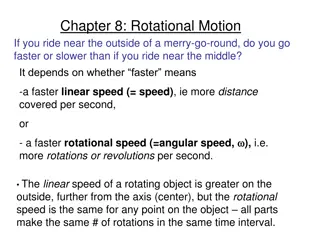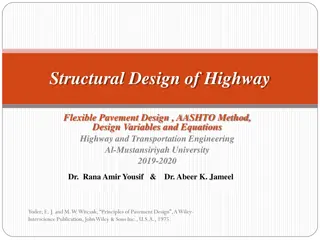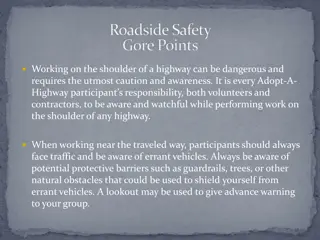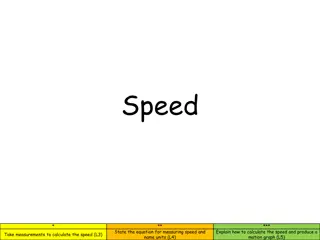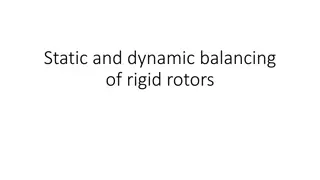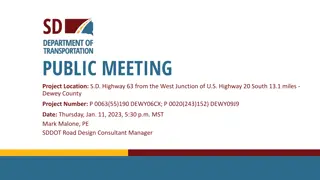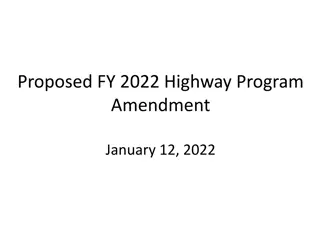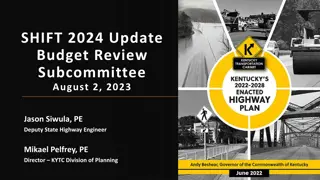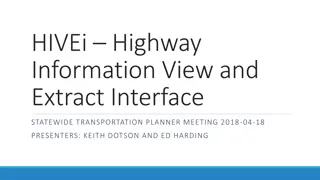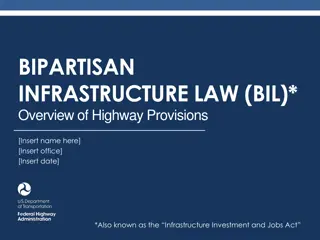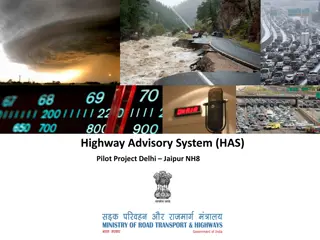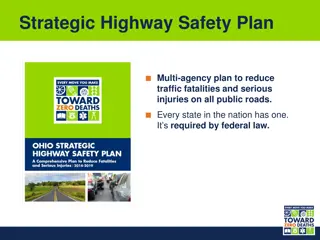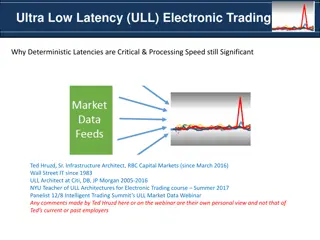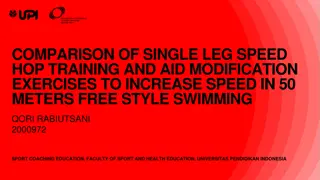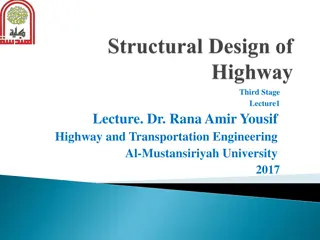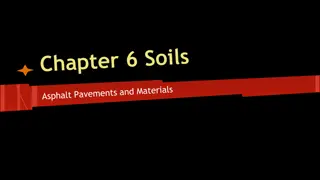Understanding Design Speed in Highway Engineering
Design speed in highway engineering refers to the selected speed used to determine the geometric features of roadways. It has evolved over time, with the current definition emphasizing safety, driver expectations, and balancing various factors like social, environmental, and economic considerations. Higher design speeds are suitable for roads of higher functional classes, with critical elements in rural areas being horizontal curves and superelevation. Factors like posted speed, operating speed, right shoulder size, and median size influence design speed decisions, with the goal of ensuring safe travel conditions for drivers.
Uploaded on Sep 21, 2024 | 0 Views
Download Presentation

Please find below an Image/Link to download the presentation.
The content on the website is provided AS IS for your information and personal use only. It may not be sold, licensed, or shared on other websites without obtaining consent from the author. Download presentation by click this link. If you encounter any issues during the download, it is possible that the publisher has removed the file from their server.
E N D
Presentation Transcript
Design Speed Bill Gulick PE PLS
Speed, Speed, Speed, Speed Running Speed Length / Time (used in cost analysis etc.) Operating Speed Observed Speed (speed studies 85thpercentile) Posted Speed White Sign (speed limit) Design Speed A selected speed used to determine the geometric features of the highway. (AASHTO 2011)
Design Speed First Defined in 1936 (by Barnett) AASHO accepted 1938 The maximum uniform speed which probably will be adopted by the faster group of drivers but not, by the small percentage of reckless ones. Definition Changed over Time 1936, 1938, 1940, 1941, 1945, 1954, 1973, 1977, 1984, 1988, 1994, 1997, 2004, 2011 AASHTO 1973 (1973 1994 + sort of) The maximum safe speed that can be maintained over a specified section of highway when conditions are so favorable that the design features of the highway govern.
Design Speed Current definition is the 14th (I think) AASHTO Green Book 2011 A selected speed used to determine the various geometric design features of the highway. 14 Words to define and 19 paragraphs advising how to pick a good (appropriate) one. Logical All feature related to obtain balance Above minimum where feasible Meet Driver Expectation (where practical) Within constraints of S.E.E. (social, environmental, economics)
Design Speed More Advice on Design Speed On low speed facilities above minimum criteria may encourage higher speeds. Higher Design Speeds are Appropriate for Higher Functional Class Roadways Design Speed is not particularly relevant in (true < 45mph)Urban Areas. (except for sight distances). Critical element in Rural Areas is Horizontal Curves and Superelevation. Design Speed should reflect the DESIRED Operating Speed
Design Speed Other Factors (more advice) Posted Speed (PS) good correlation with Operating Speed (OS) Design Speed (DS) little correlation with OS DS < PS = Lower Speeds (minor correlation) DS > PS = Higher Speeds (more correlation) Bigger Right Shoulder = Higher Speeds Bigger Median = Higher Speeds Note lack of the word safe in new definition. Liability Associated with DS vs. PS over stated.
Design Speed KYTC Highway Design Manual (2008 edition) Design Speed is a selected speed used to determine the various geometric features of the roadway. It is the highest continuous speed at which individual vehicles can travel with safety upon a highway when weather conditions are favorable, traffic density is low, and the geometric design features of the highway are the governing conditions for safe speed. 1970 s again in mid 90 s (not mid 80 s) . Until 1994
Design Speed DESIGN SPEED Per revised NEW DESIGN MANUAL: KYTC HD-703 Design speed is a selected speed used to determine the various geometric features of the roadway. The selected design speed should be a logical one with respect to the anticipated operating speed, topography, the adjacent land use, and the functional classification of the highway. In selecting the design speed, every effort should be made to attain a desired combination of safety, mobility, and efficiency within the constraints of environmental impacts, economics, project scope, aesthetics, and social or political impacts. The selected design speed should be consistent with the speed that drivers are likely to expect on a given highway facility. For a further discussion of the philosophy of design speed, see AASHTO's A Policy on Geometric Design of Highways and Streets .
Design Speed 2011 AASHTO Green Book Minimum Recommended Design Speeds Local Roadways: Rural Local: Chapter 5, Section 5.2.1, Table 5-1 (Minimum Design Speed for Local Rural Roads). Urban Local: Chapter 5, Section 5.3.1 Collector Roadways: Rural Collector: Chapter 6, Section 6.2.1, Table 6-1 (Minimum Design Speed for Rural Collectors). Urban Collector: Chapter 6, Section 6.3.1 Arterial Roadways: Rural Arterial: Chapter 7, Section 7.2.2 Urban Arterial: Chapter 7, Section 7.3.2
Design Speed 2005 AASHTO Design Standards Interstate System Interstates Rural: Page 2 Urban: Page 2 2016 KYTC Highway Design Manual Chapter 700 Geometric Design Guidelines: Exhibit 700-01 COMMON GEOMETRIC PRACTICES RURAL LOCAL ROADS Exhibit 700-02 COMMON GEOMETRIC PRACTICES RURAL COLLECTOR ROADS Exhibit 700-03 COMMON GEOMETRIC PRACTICES RURAL ARTERIAL ROADS Exhibit 700-04 COMMON GEOMETRIC PRACTICES URBAN ROADWAYS
Design Speed FHWA OLD 13 Controlling Criteria (1985) FHWA NEW 10 2 (KYTC) Controlling Criteria (2016) 1. 1. Design Speed Design Speed 2. Lane Width 2. Lane Width 3. Shoulder Width 3. Shoulder Width 4. Horizontal Curve 4. Bridge Width 5. Superelevation Rate 5. Structure Capacity 6. Stopping Sight Distance (SDD) 6. Horizontal Alignment 7. Maximum Grade 7. Vertical Alignment 8. Cross-Slope 8. Grade 9. Vertical Clearance 9. Stopping Sight Distance 10. Design Load (Structure Capacity) 10. Cross-Slope 11. Superelevaion Under 50 mph 1. Design Speed 2. Design Load (Structure Capacity) 12. Vertical Clearance 13. Horizontal Clearance/Lateral Offset
Design Speed THANK YOU ANY QUESTIONS??



